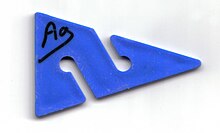

- Top: Line arrow - directional information - points along the line leading to the nearest surface with breathable air
- Middle: Cookie - non-directional personal marker
- Bottom: Hybrid/referencing exit marker - directional personal marker
In cave (and occasionally wreck) diving, line markers are used for orientation as a visual and tactile reference on a permanent guideline. Directional markers (commonly a notched acute isosceles triangle in basic outline), are also known as line arrows or Dorff arrows, and point the way to an exit. Line arrows may mark the location of a "jump" location in a cave when two are placed adjacent to each other. Two adjacent arrows facing away from each other, mark a point in the cave where the diver is equidistant from two exits. Arrow direction can be identified by feel in low visibility.
Non-directional markers ("cookies") are purely personal markers that mark specific spots, or the direction of one's chosen exit at line intersections where there are options. Their shape does not provide a tactile indication of direction as this could cause confusion in low visibility. One important reason to be adequately trained before cave diving is that incorrect marking can confuse and fatally endanger not only oneself, but also other divers.
